Employee Benefits Survey: The Complete Guide [+ 13 Questions]

Picture this: one of your key goals for this year is to redesign the employee benefit structure as part of a bigger employer branding and recruiting strategy.
Since joining the organization a few months back, you’ve been hearing complaints indicating that employees aren’t satisfied with the benefit offerings or benefits are simply not used causing budget waste. Anecdotal data isn’t enough to make informed decisions though.
Solution?
A thorough employee benefit analysis, starting with an employee benefits survey.
From the article, you will learn best practices for running such surveys and what questions to ask.
Before that, let’s deal with some basics.
What is an employee benefits survey?
An employee benefits survey is a questionnaire used to collect employee feedback regarding the benefits and perks you offer.
These surveys aim to gauge satisfaction levels with their current benefits package and learn how to enhance it to better meet expectations.
It can also help you understand how your organization stacks against other companies in your industry. So that your benefits offerings remain competitive.
Why are employee benefits important?
Employee benefits are vital for a few reasons.
➡️ Firstly, a robust benefits package helps attract top talent. Zest has found that 55% of 18-34-year-olds find it the most important factor when looking for a new role.
➡️ Secondly, benefits are key to employee satisfaction and engagement. According to SHRM data, 92% of employees find benefits affect their job satisfaction. This is linked to employee loyalty and retention.
Benefits such as health insurance, wellness programs, mental health support, and sick leave are vital for maintaining employee physical and mental well-being. They reduce absenteeism (and presenteeism), and according to ABI - they increase productivity.
Higher productivity and better focus can also be attributed to benefits that support employees’ personal lives, like flexible working hours and childcare assistance.
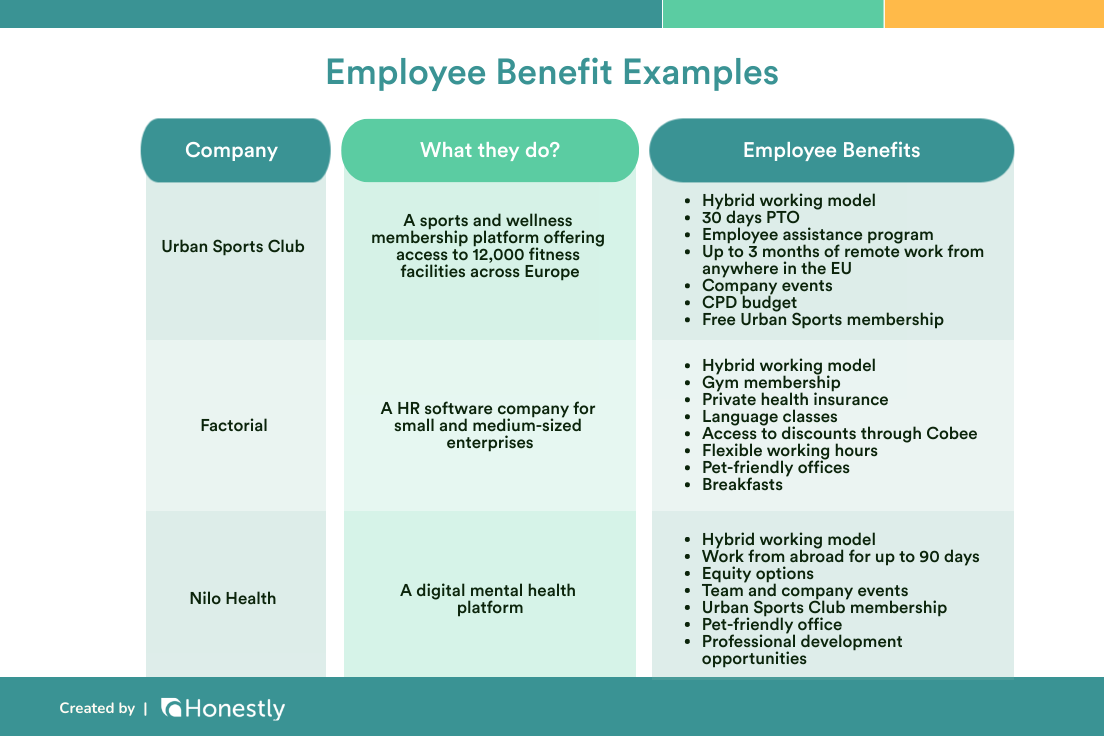
When to run an employee benefits survey
✅ Considering the importance of employee benefits packages, the surveys should be one of the key pillars of your corporate listening strategy. Run them regularly to ensure that your benefits offerings reflect employee preferences and remain attractive.
✅ Apart from regular, say annual, surveys, consider conducting them after implementing new benefits. To assess their effectiveness and impact on employee satisfaction and well-being.
✅ Finally, run employee benefits during times of organizational change. Like mergers, acquisitions, or shifts in work patterns.
💡For example, if your company is trying to encourage more employees to return to the office, you may need to change your benefits structure to better support staff.
Employee benefits survey vs. satisfaction survey
The employee benefits survey is specifically designed to gather feedback on the various benefits provided by an organization, such as health insurance, retirement plans, paid time off, and wellness programs.
It focuses solely on understanding how employees perceive and value their benefits package.
Unlike the benefits-focused survey, an employee satisfaction survey takes a broader perspective. It covers a wide range of topics, including workplace environment, management quality, job roles, career development opportunities, and work-life balance.
The purpose is to gain comprehensive insights into how employees feel about their jobs and the company as a whole.
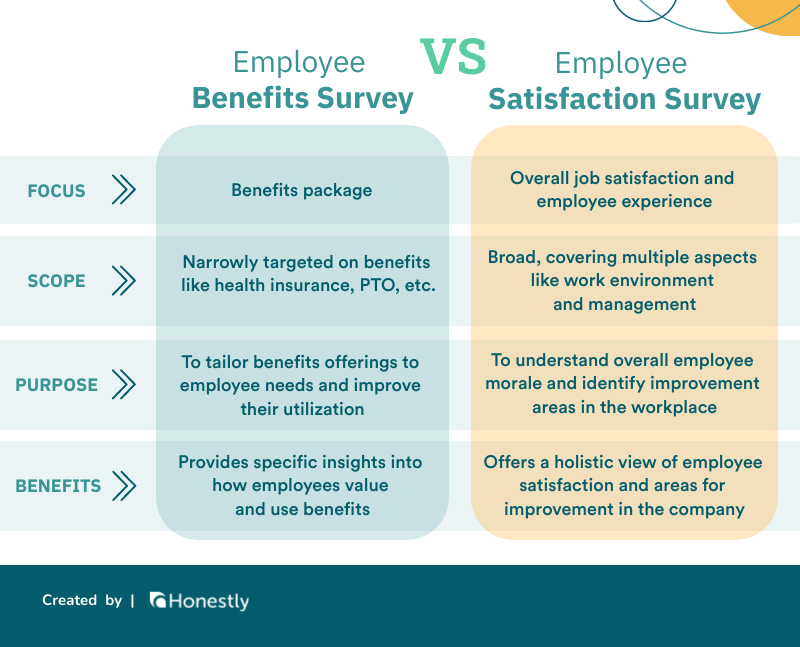
13 example employee benefit questions
With the theory out of the way, let’s dissect the 13 questions from our employee benefits survey template.
1. How satisfied are you with the benefits offered by your organization?
This rating question tests the overall satisfaction with the current benefits package.
High satisfaction indicates that the benefits are valued, which can enhance employee job satisfaction and retention. Companies offering attractive benefits packages have 56% lower attrition rates.
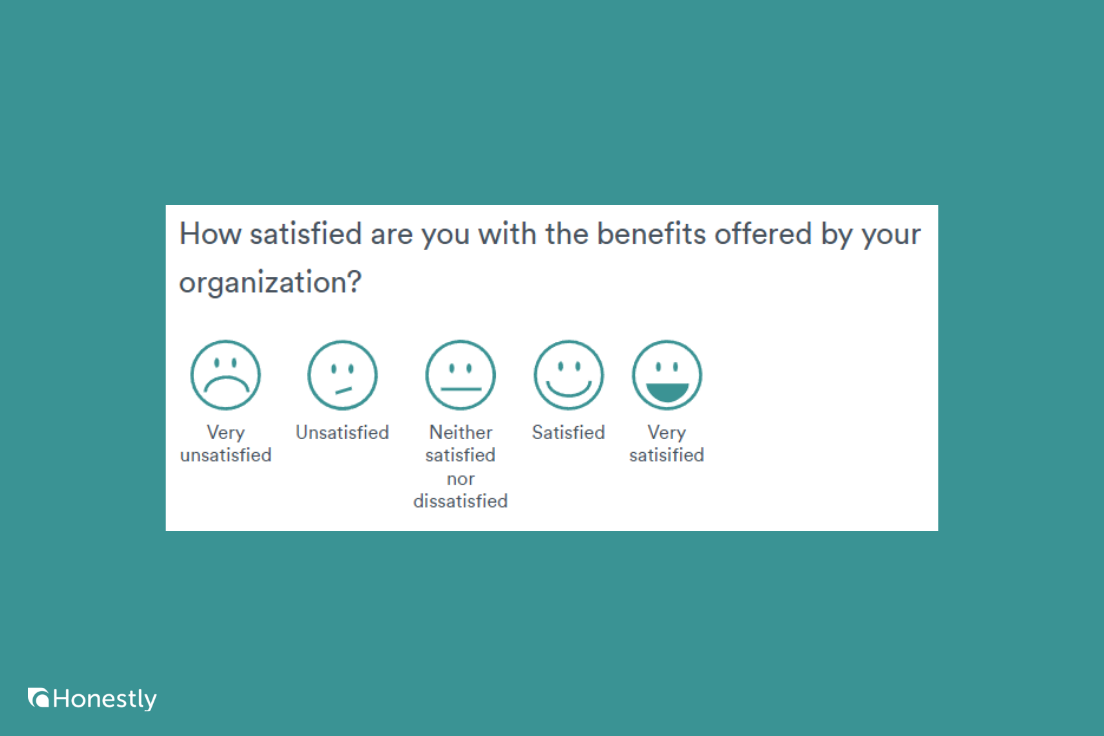
2. I have a clear understanding of the benefits packages offered by my organization.
By asking this agree/disagree question, you test how effectively your company communicates about the available benefits.
Why does it matter?
Even the best benefits are ineffective if employees don’t know about them. Clear communication ensures that employees get the most out of the benefits you offer.
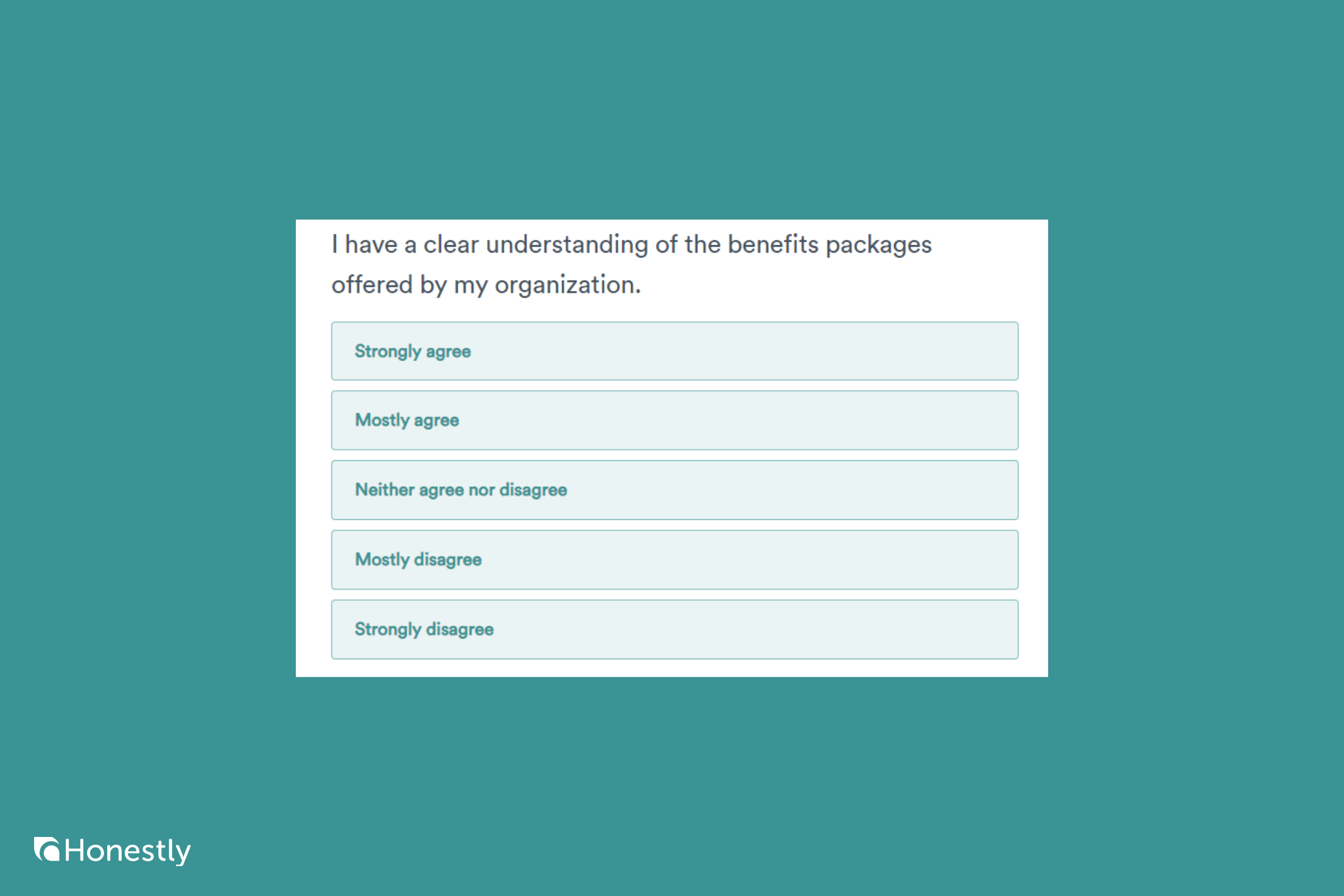
3. When I joined the company, all benefits were explained to me clearly and thoroughly.
Just like the previous question, this agree/disagree question assesses how effectively you communicate about the benefits offerings, with a focus on new employee orientation.
A clear explanation of benefits during onboarding helps new employees understand and appreciate their benefits. It also sets clear expectations and prevents disappointment.
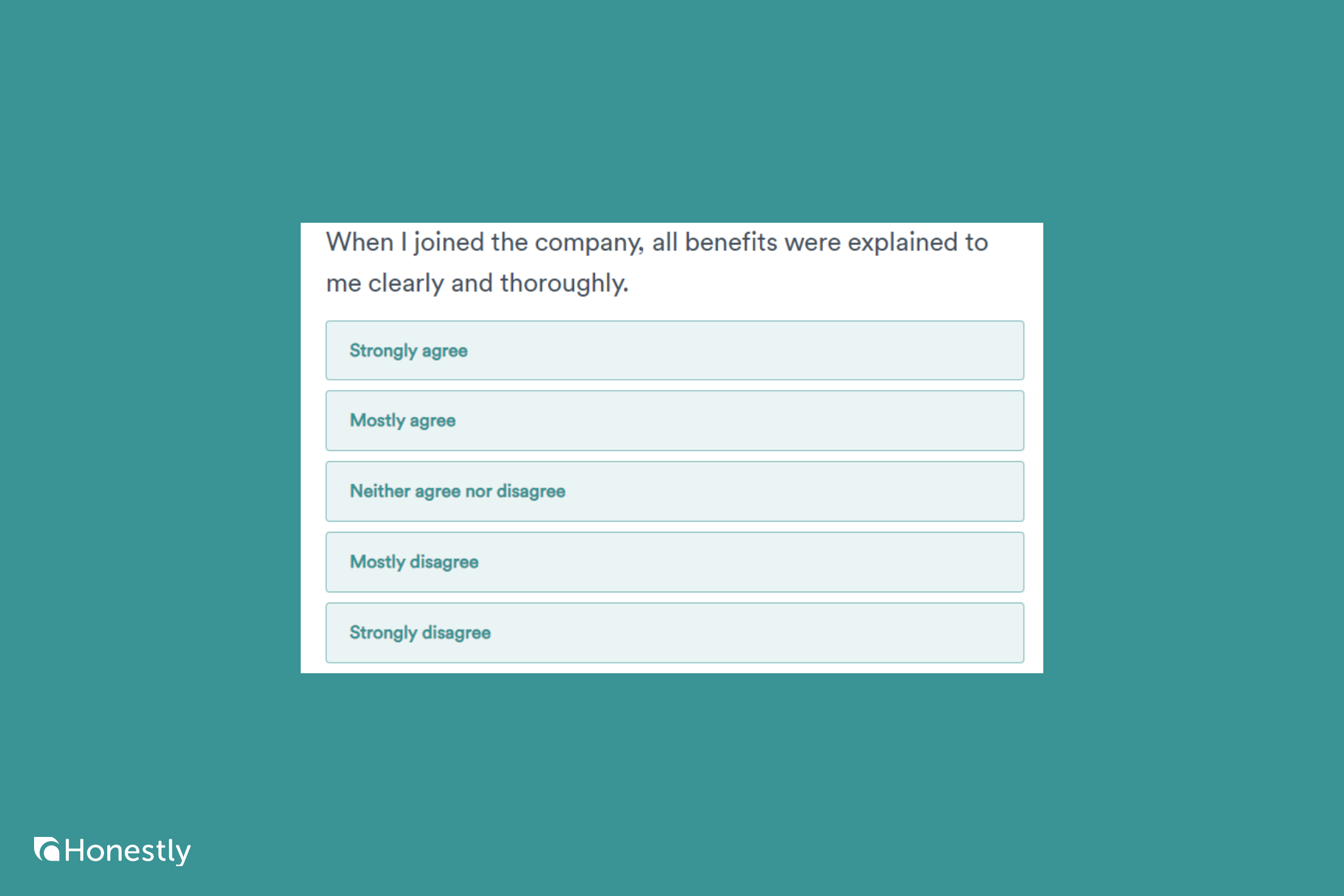
4. The benefits my organization offers can compete with those offered by other organizations.
This is another agree/disagree question and it offers insights into the perceived competitiveness of the benefits package relative to other employers.
Understanding how your benefits compare to those of competitors helps you maintain a competitive edge to attract and retain the best employees. 60% of employees consider them when accepting a job offer.

5. How satisfied are you with your organization’s vacation policy?
This could be a Likert scale, smiley face, or star rating question, and it measures satisfaction with vacation and paid time off policies.
Why should you care?
Adequate vacation policies are crucial for work-life balance and preventing burnout. Employees who have opportunities to switch off during their vacation are less likely to suffer from work-related stress and are more productive.
German companies offer 25-30 days of paid annual leave in addition to the 10-12 public holidays. For example, Siemens employees enjoy 30 days of paid time off every year.
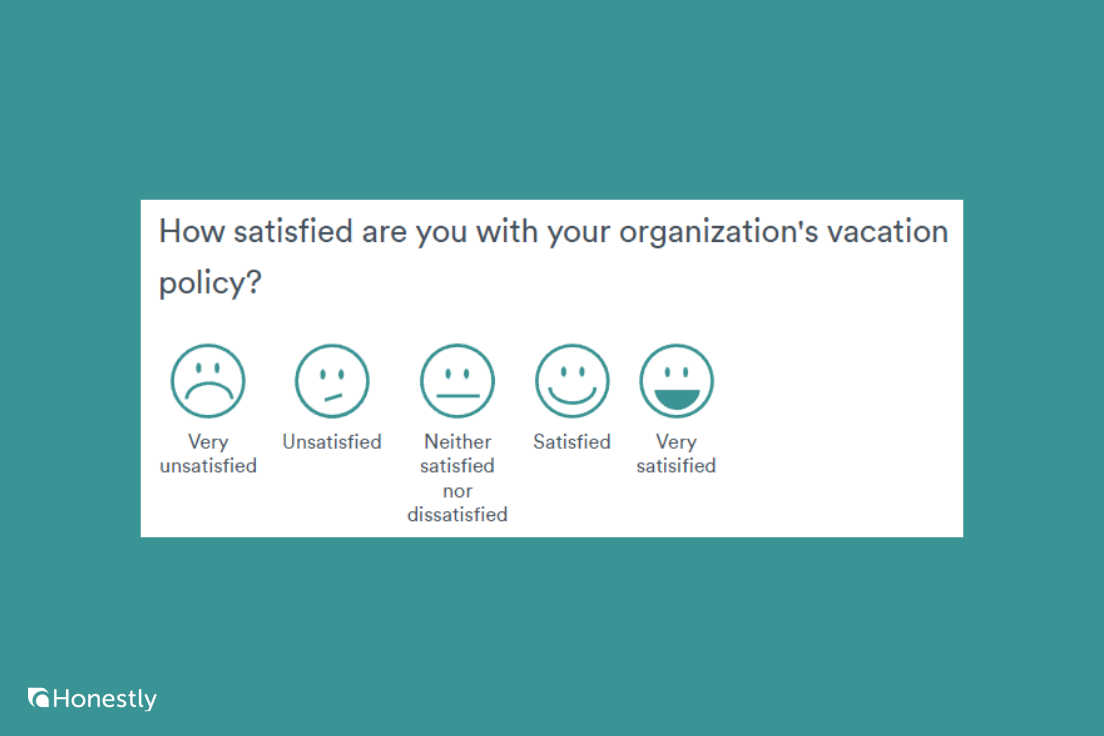
6. How satisfied are you with your organization’s meal allowances and allocation?
If your company offers meal-related benefits, this question allows you to evaluate staff satisfaction with them.
Meal perks can contribute to a positive workplace culture: teams that eat together are more productive and collaborate better. And meal perks can be a way to encourage employees to get back to the office.
According to Ravio, 17% of companies in Germany provide everyday breakfast and 15% - lunch. For example, Google Germany offers staff free meals and snacks throughout the day.
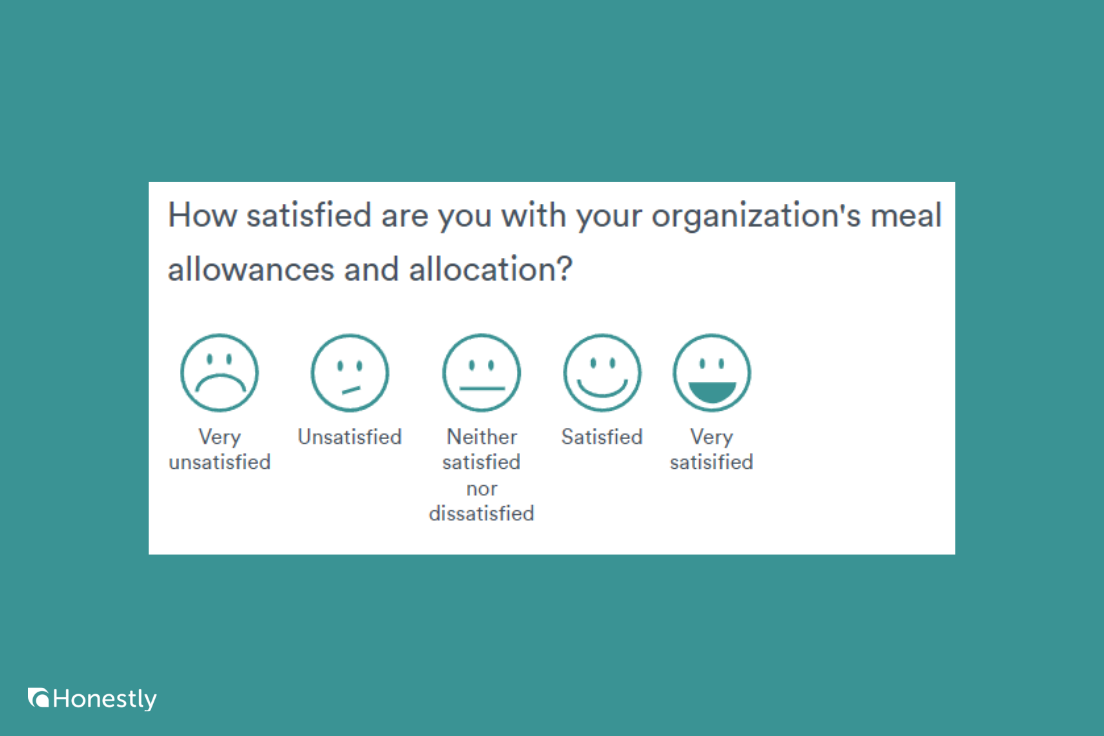
7. How satisfied are you with your organization’s break time allocation?
Use this question to measure how contented staff are with the amount and frequency of breaks during the workday.
In Germany, your staff is legally entitled to a 30-minute break if they work for 6-9 hours, and in certain lines of work, breaks are essential for their safety.
By giving employees a chance to recharge their batteries and disconnect from work, regular breaks boost staff performance and creativity.

8. How satisfied are you with your organization’s training/skill development program?
The question looks at satisfaction with professional development opportunities.
Access to training and development is key to employee retention. The 2018 Workplace Learning Report found that 94% of employees would be willing to stay in their current roles if they received better training opportunities. Better yet, 83% of HR professionals believe growth opportunities help attract candidates.
German employers often recognize the need for professional development by sponsoring their employees’ studies and training. Many, like Audi, offer internal qualification schemes (Audi Academy) to facilitate their growth.
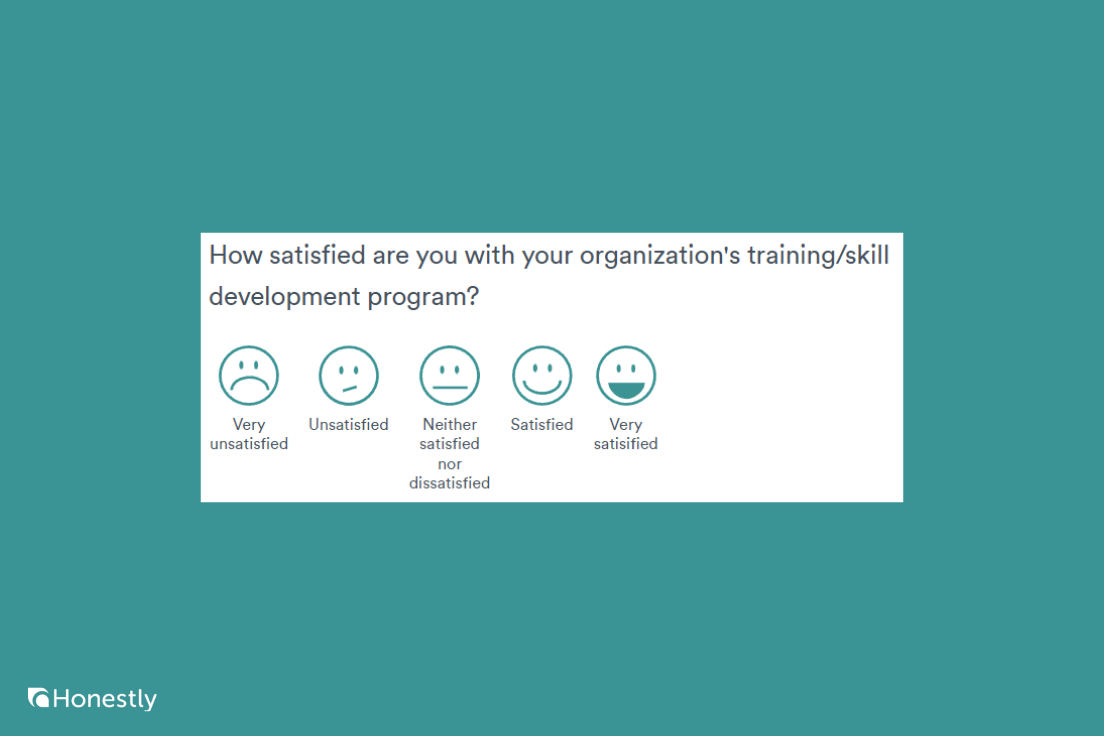
9. How satisfied are you with your working hours?
The question assesses whether employees are satisfied with their schedules and flexibility of working hours.
This matters because working hours and flexibility directly impact work-life balance and employee satisfaction.
They also affect staff performance: flexible working hours improve staff performance because they can choose to work when they’re most productive. The flexibility allows them to attend to other life matters, like school runs, so they’re less distracted once they sit down to work.
Since the COVID-19 pandemic, many German companies, like Bayer, have been offering flexible working arrangements like compressed work weeks or job sharing. 88% of German employers offer hybrid working.
How does it work at Honestly?
We have the flexibility to start and finish work earlier or later, or have a longer break, for example, for childcare. As long as you get the work done and it has no negative impact on team dynamics.
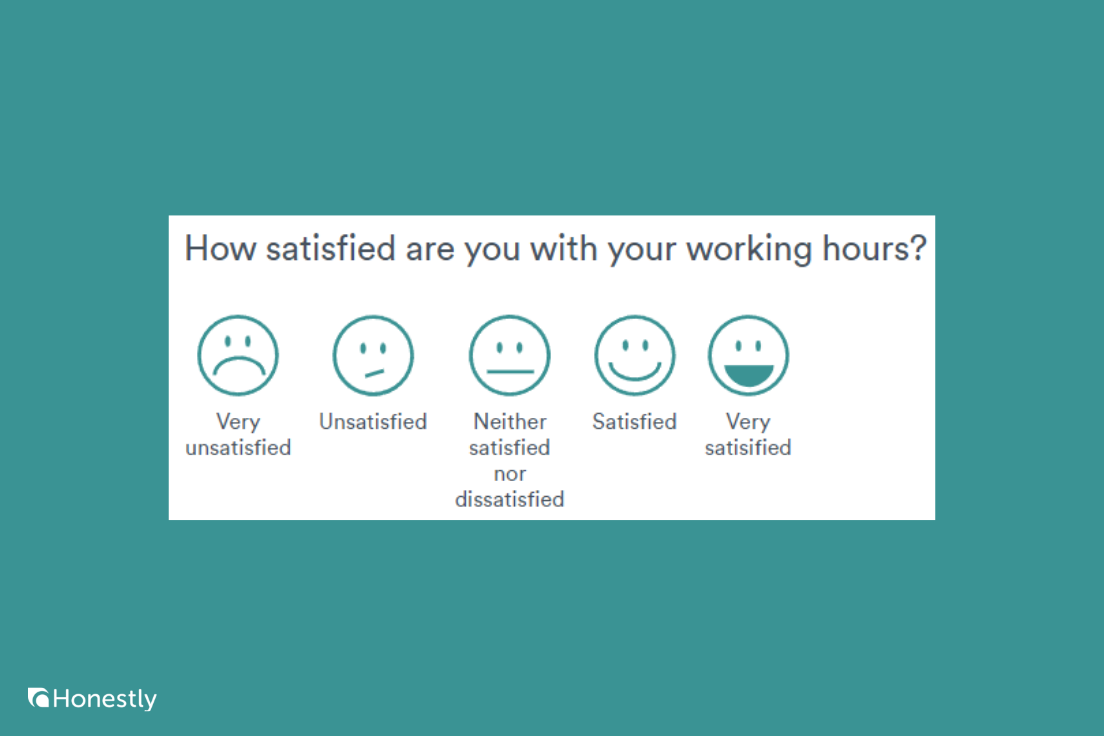
10. Which three benefits already offered by your organization are most important to you?
Ask this question to identify the most valued existing benefits.
Knowing which benefits are most important to employees helps prioritize resources and plan future benefit offerings. What’s more, the question reminds employees what benefits are available to enhance their utilization.

11. What is the 1 benefit that your organization does not yet offer and that you would like to have?
This question can help you pinpoint gaps in the current benefits package and identify new benefits employees desire.
By addressing these gaps, you can align your offerings with staff preferences and significantly improve employee satisfaction. Moreover, you send your employees a signal that their voice and preferences are valued.

12. Based on the offered benefits, how likely are you to recommend your organization as an employer to friends and family?
This NPS-style question tests employee advocacy and the likelihood of recommending the company based on benefits.
The willingness to recommend the company indicates that employees are satisfied with their benefits, which is crucial for employer branding and new staff recruitment. It can also help you identify staff ready to participate in referral programs and recruitment events.
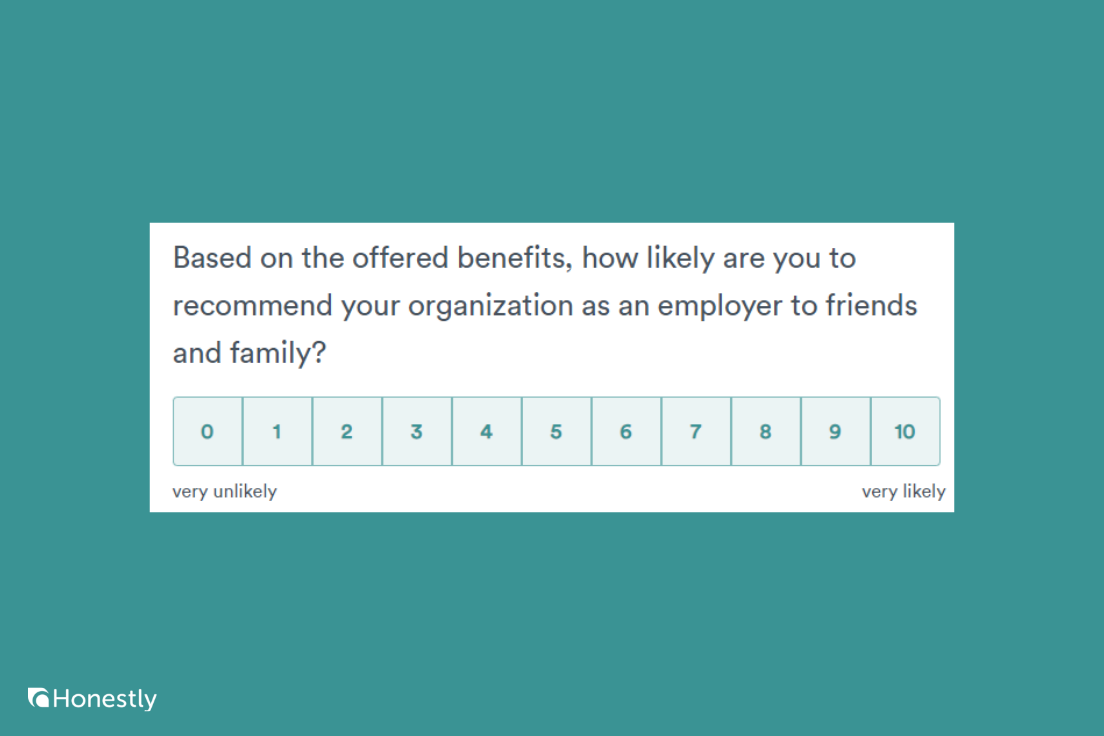
13. Do you have any additional comments, criticisms, or suggestions regarding your organization’s benefit policy?
Use this question to collect qualitative feedback on the benefits policy and identify opportunities to enhance it.
Open-ended responses provide detailed insights into specific issues or innovative ideas you might not capture through structured questions.
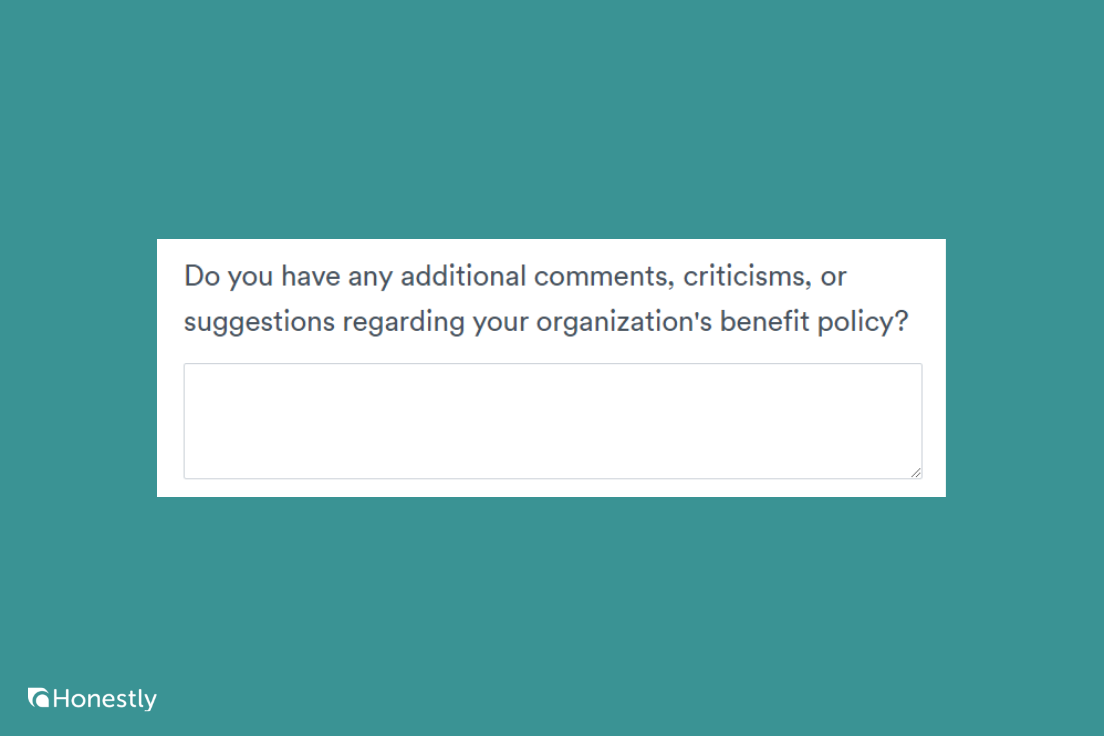
Employee Benefits Survey best practices
Define clear objectives
Clearly outlining your survey goals helps you determine what information you want to gather.
In this way, you avoid asking irrelevant or distracting questions.
For example, if your goal is improving healthcare benefits, focus questions on current satisfaction with health insurance, preferred providers, and desired changes in coverage.
Ask clear questions
To achieve high response rates and reliable insights, ensure the questions are easy to understand. Use direct questions, avoid jargon, complex language, and double-barrelled questions.
For instance, instead of asking “How satisfied are you with your healthcare and dental plans?”, ask two separate questions “How satisfied are you with your healthcare plan?” and “How satisfied are you with your dental plan?”
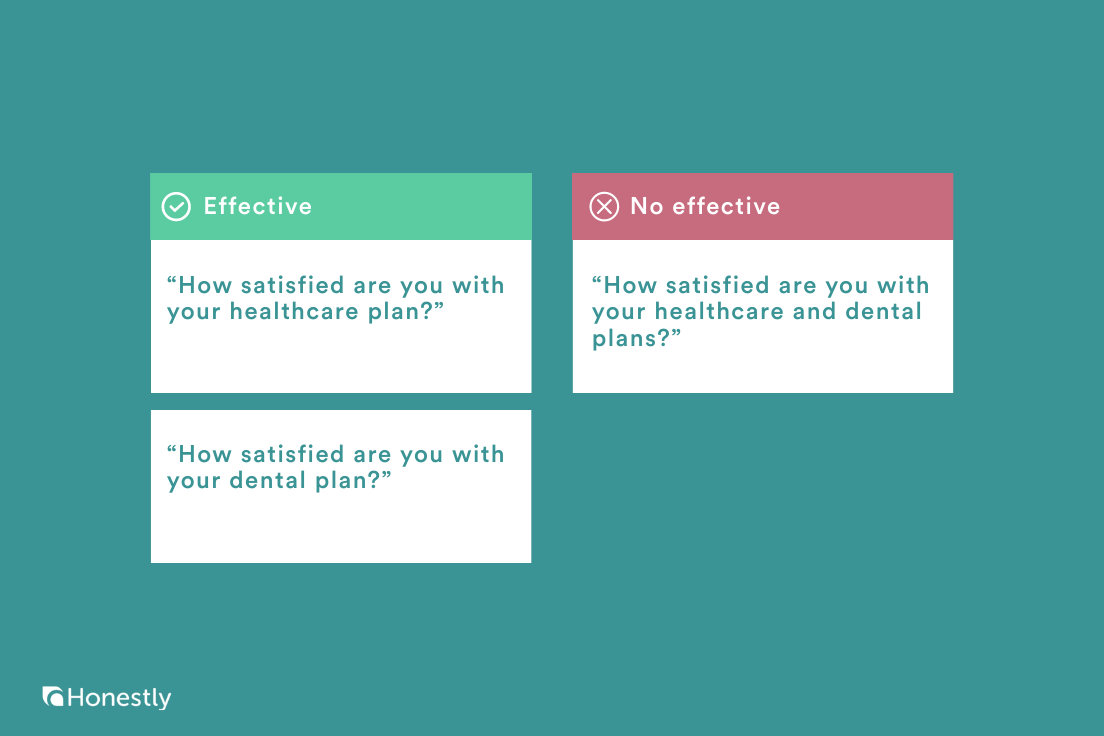
Use a range of questions
Embedding a range of question types in the survey allows you to gather diverse insights and makes it more inclusive.
For example, closed-ended questions like ‘How satisfied are you with your working hours?’ allow you to measure trends over time and spot issues but give you a limited understanding of how to improve. So it’s good practice to follow them up with open-ended ones.
Best part?
AI tools, like Honestly’s AI assistant, have simplified qualitative feedback analysis, so there’s no reason to avoid them.
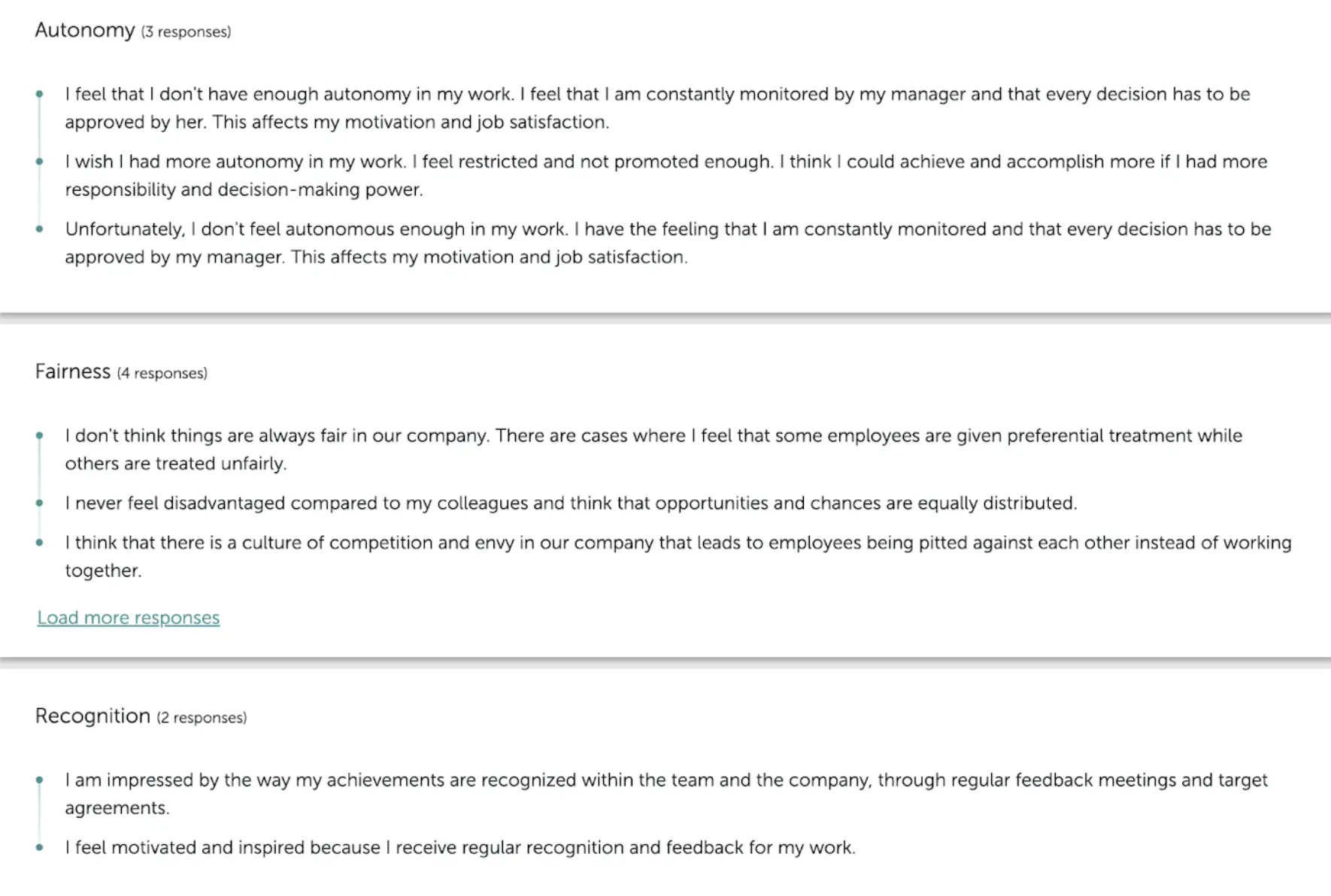
Keep your staff in the loop
Keep your staff informed throughout the survey process.
Before the survey, inform your teams about the timing and its purpose. Explain how you’re planning to gather and analyze the data. And how you’re going to protect their privacy and ensure confidentiality.
When the employee submits the survey, let them know when they can expect the results, and once they are ready - how you’re planning to use them to inform the benefits policy.
Use a reputable survey platform
Free solutions like G-forms are good enough for a one-off survey now and again. However, if you’re building a comprehensive corporate listening strategy, consider using a dedicated survey platform.
Tools like Honestly, help you automate survey administration and data analysis. It also helps you ensure compliance with data protection legislation like GDPR and guarantee anonymity.
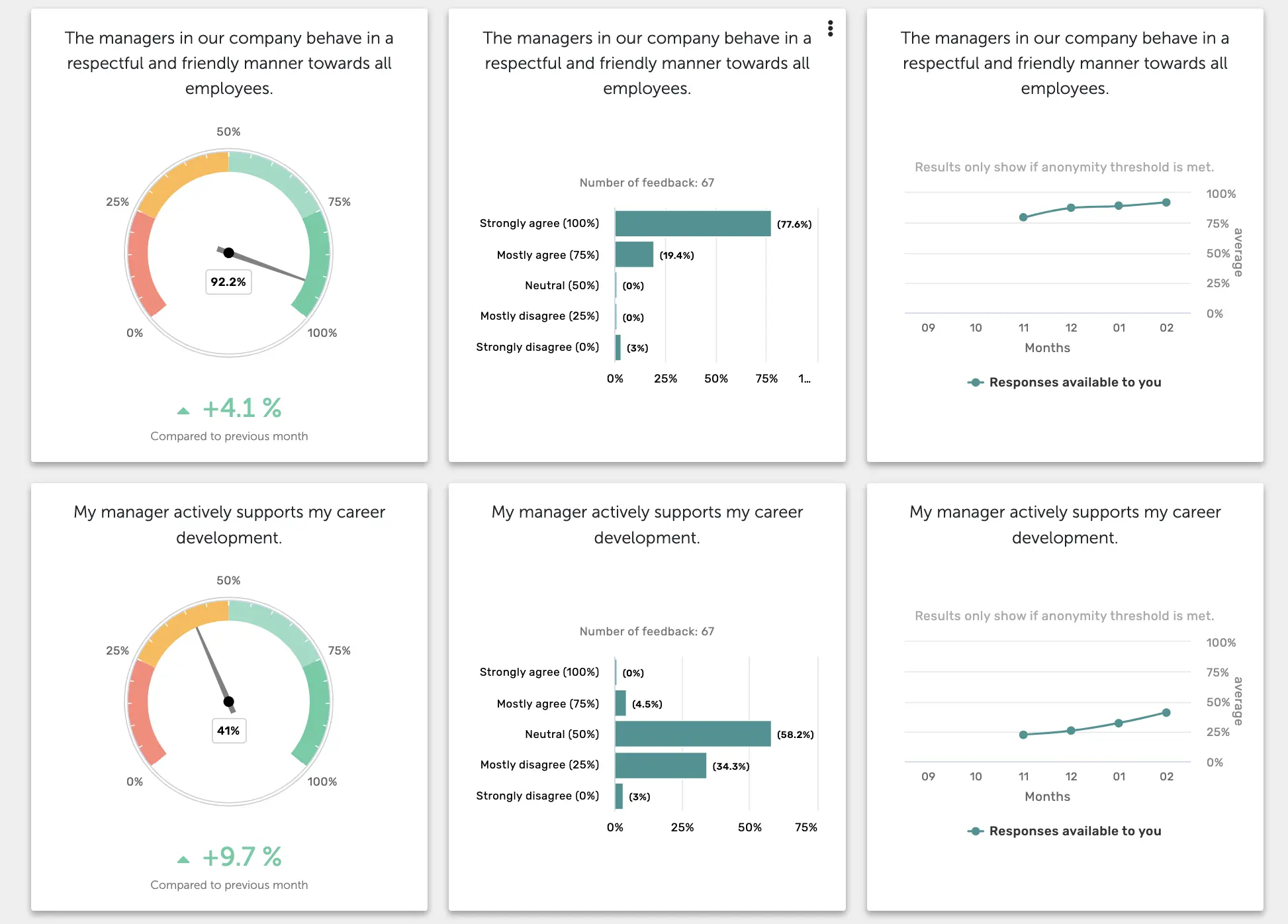
Employee opinion survey FAQs
How do you analyze employee benefits?
Start by listing all the benefits that you offer, along with the cost. Next, gather data on their utilization. This will help you identify the most popular benefits and determine which of them offer the best value for money.
For example, you may learn that you don’t have to spend a lot on benefits that employees value the most.
For more in-depth insights, cross reference the data with employee benefits and satisfaction survey results, and sickness and absence, or turnover rates. In this way, you can identify the benefits that impact the metrics the most.
What employees value most in 2024?
According to Forbes Advisor, top benefits for employees are employer-covered healthcare (67% of employees), life insurance (45%), pension and retirement plans (34%), mandatory paid time off (31%), and mental health assistance (23%).
Remote workers value flexible working hours, work-provided equipment, and home office stipends the most. These were the top benefits for 34%, 26%, and 17% of employees respectively.
What is a typical compensation package?
What a typical compensation package looks like depends on your industry and location. For example, US companies tend to offer less PTO than European counterparts.
To design a competitive benefits package, use employee benefits benchmark reports like the one from CBIZ. You can also keep up with benefits trends by analyzing data from Glassdoor or studying job postings on LinkedIn and job sites like Indeed.
Finally, your competitors’ websites could shed some light on where you can improve your offerings.

